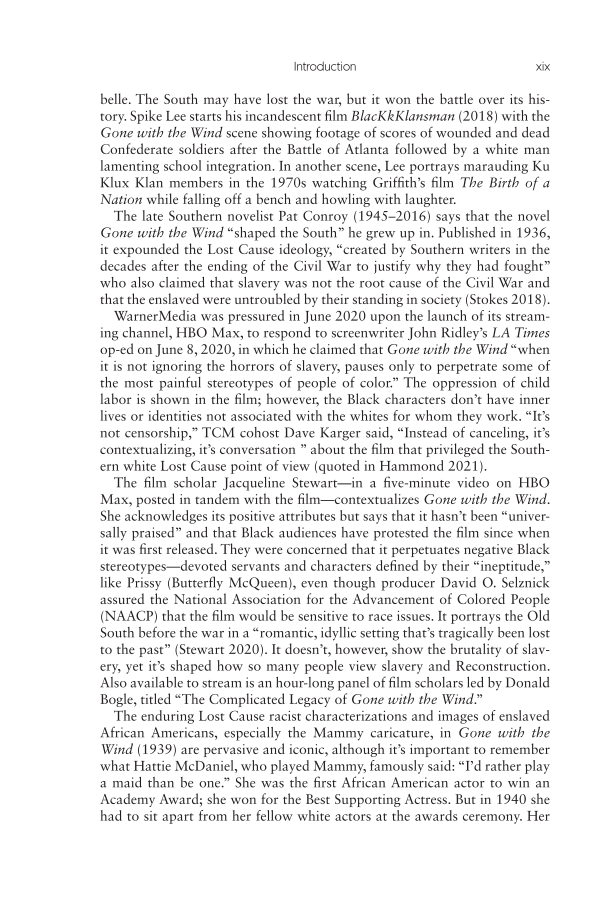Introduction xix belle. The South may have lost the war, but it won the battle over its his- tory. Spike Lee starts his incandescent film BlacKkKlansman (2018) with the Gone with the Wind scene showing footage of scores of wounded and dead Confederate soldiers after the Battle of Atlanta followed by a white man lamenting school integration. In another scene, Lee portrays marauding Ku Klux Klan members in the 1970s watching Griffith’s film The Birth of a Nation while falling off a bench and howling with laughter. The late Southern novelist Pat Conroy (1945–2016) says that the novel Gone with the Wind “shaped the South” he grew up in. Published in 1936, it expounded the Lost Cause ideology, “created by Southern writers in the decades after the ending of the Civil War to justify why they had fought” who also claimed that slavery was not the root cause of the Civil War and that the enslaved were untroubled by their standing in society (Stokes 2018). WarnerMedia was pressured in June 2020 upon the launch of its stream- ing channel, HBO Max, to respond to screenwriter John Ridley’s LA Times op-ed on June 8, 2020, in which he claimed that Gone with the Wind “when it is not ignoring the horrors of slavery, pauses only to perpetrate some of the most painful stereotypes of people of color.” The oppression of child labor is shown in the film however, the Black characters don’t have inner lives or identities not associated with the whites for whom they work. “It’s not censorship,” TCM cohost Dave Karger said, “Instead of canceling, it’s contextualizing, it’s conversation ” about the film that privileged the South- ern white Lost Cause point of view (quoted in Hammond 2021). The film scholar Jacqueline Stewart—in a five-minute video on HBO Max, posted in tandem with the film—contextualizes Gone with the Wind. She acknowledges its positive attributes but says that it hasn’t been “univer- sally praised” and that Black audiences have protested the film since when it was first released. They were concerned that it perpetuates negative Black stereotypes—devoted servants and characters defined by their “ineptitude,” like Prissy (Butterfly McQueen), even though producer David O. Selznick assured the National Association for the Advancement of Colored People (NAACP) that the film would be sensitive to race issues. It portrays the Old South before the war in a “romantic, idyllic setting that’s tragically been lost to the past” (Stewart 2020). It doesn’t, however, show the brutality of slav- ery, yet it’s shaped how so many people view slavery and Reconstruction. Also available to stream is an hour-long panel of film scholars led by Donald Bogle, titled “The Complicated Legacy of Gone with the Wind.” The enduring Lost Cause racist characterizations and images of enslaved African Americans, especially the Mammy caricature, in Gone with the Wind (1939) are pervasive and iconic, although it’s important to remember what Hattie McDaniel, who played Mammy, famously said: “I’d rather play a maid than be one.” She was the first African American actor to win an Academy Award she won for the Best Supporting Actress. But in 1940 she had to sit apart from her fellow white actors at the awards ceremony. Her
Document Details My Account Print multiple pages
Print
You have printed 0 times in the last 24 hours.
Your print count will reset on at .
You may print 0 more time(s) before then.
You may print a maximum of 0 pages at a time.
















































































































































































































































